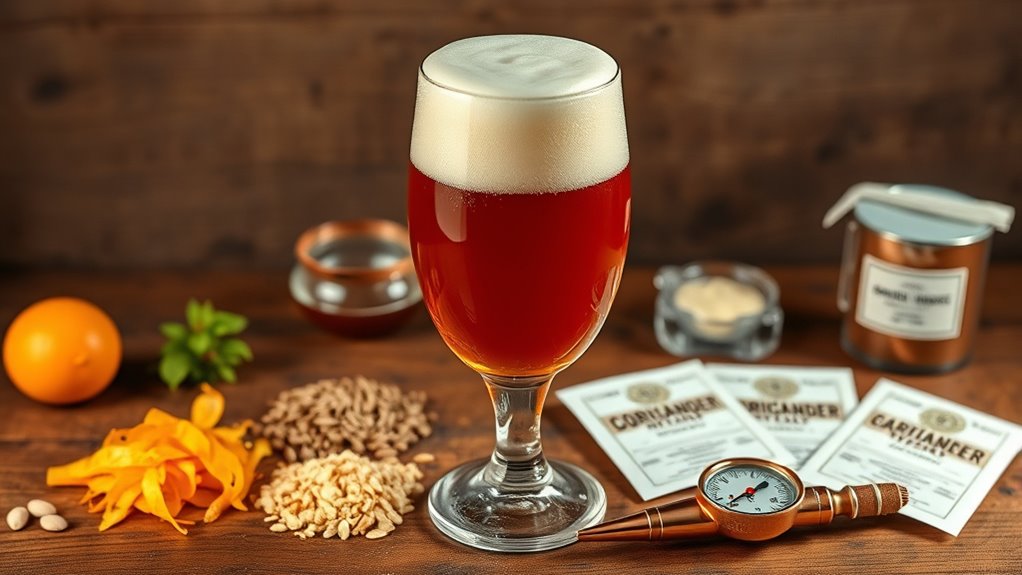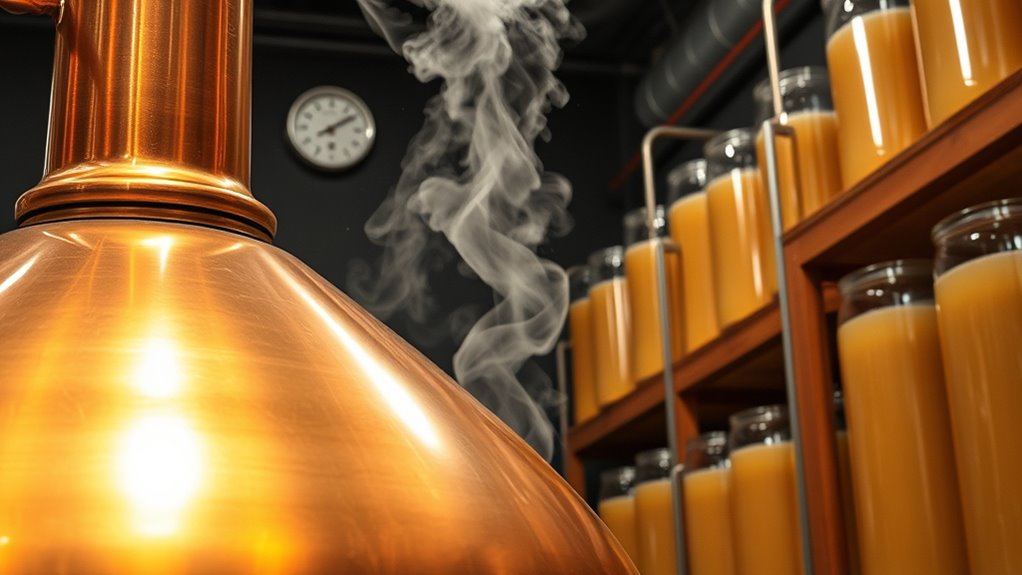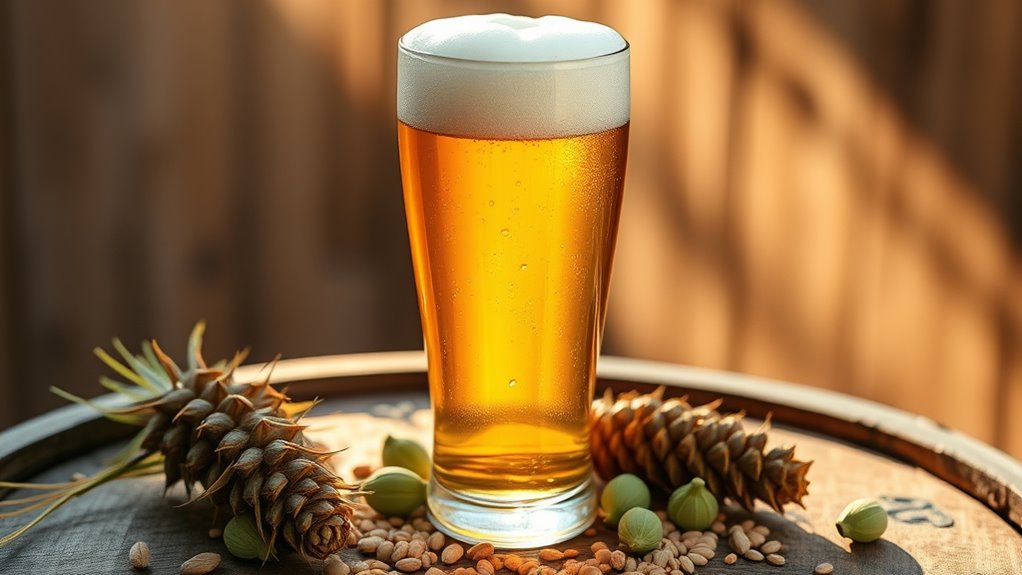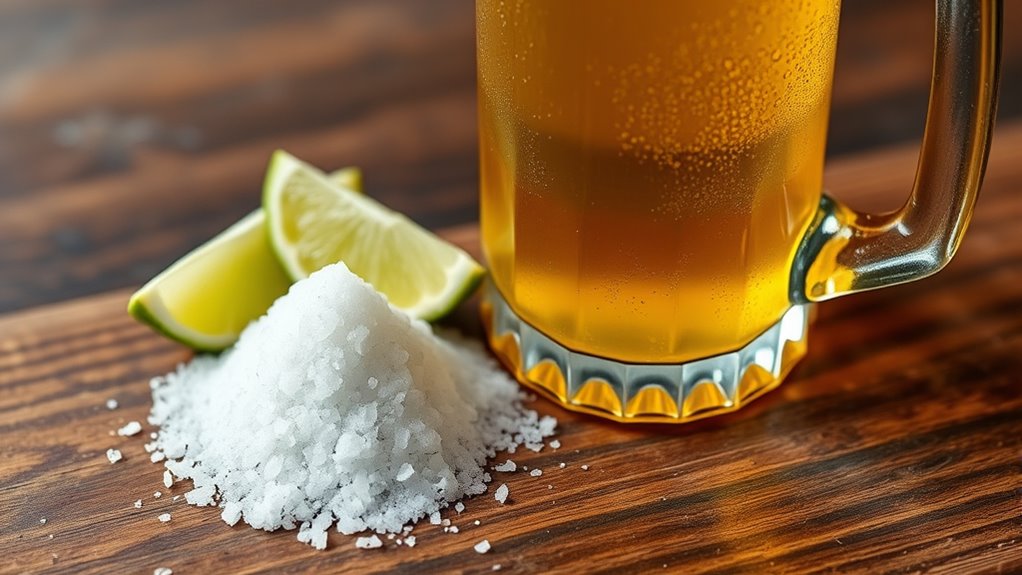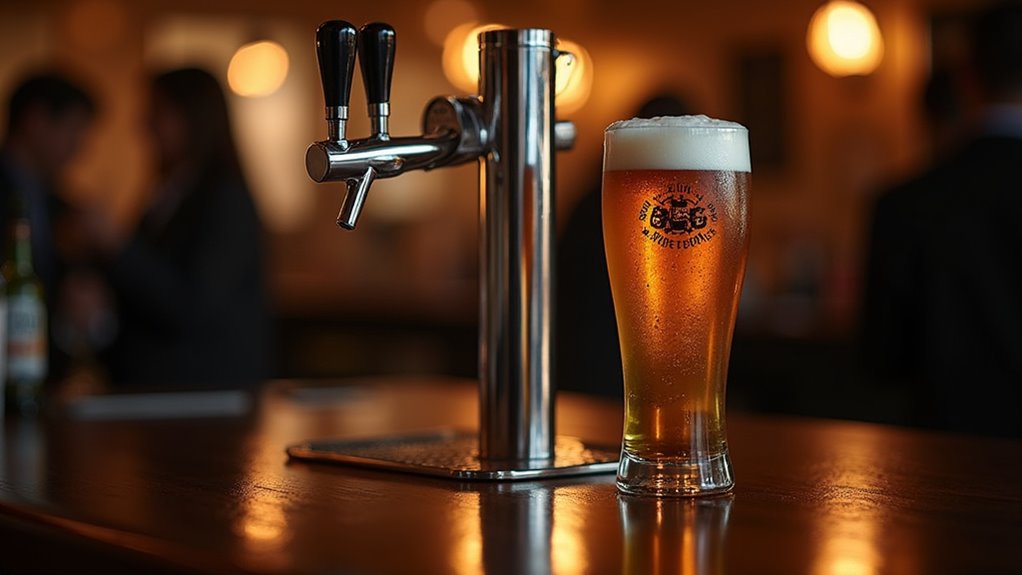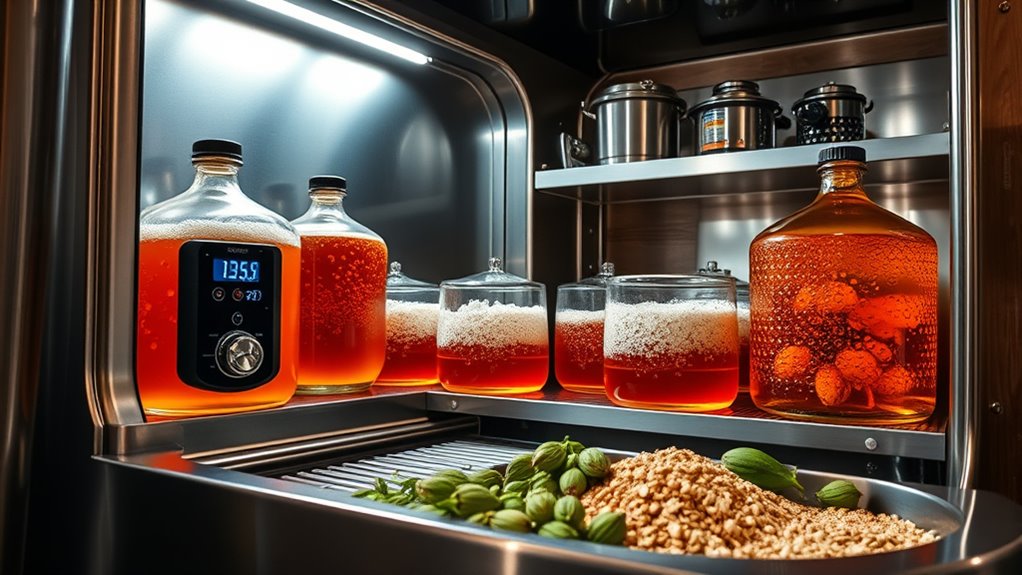To succeed in Belgian ale competitions, you’ll need to adhere to key guidelines. Focus on styles like Dubbel and Tripel, ensuring you use proper ingredients such as Belgian Pilsner malt and appropriate yeast strains. Maintain fermentation temperatures between 60-68 °F and conduct a diacetyl rest. Clarity is essential, so consider cold crashing before bottling. Avoid common mistakes like neglecting sanitation and over-pitching yeast. By following these tips, you’ll position your brew for success and discover more insights as you explore further.
At a Glance
- Align your Belgian ale with BJCP guidelines, focusing on style-specific characteristics like aroma, flavor, and mouthfeel.
- Maintain a clean brewing environment to avoid sanitation issues that can negatively impact flavor and clarity.
- Monitor fermentation temperatures closely to promote desired esters and ensure proper yeast performance.
- Allow for a diacetyl rest post-fermentation to improve flavor development and overall quality.
- Document your brewing process and judges’ feedback to refine techniques and enhance future competition entries.
Overview of Belgian Ale Styles
Belgian ales represent a diverse range of beer styles that are known for their unique characteristics and rich flavors.
You’ll encounter varieties like Belgian Dubbel, Tripel, and Quadrupel, each boasting distinct flavor profiles and alcohol content ranging from 5% to 12% ABV.
These ales often showcase a complex malt character, featuring notes of caramel and dark fruit, enhanced by specific yeast strains that add fruity esters and spicy phenols.
Hop varieties play a supporting role, balancing bitterness with moderate IBU levels.
Embrace the innovation within these styles, and you’ll find options suitable for social enjoyment or more refined tasting experiences.
Helpful Hints:
- Explore various styles to discover your favorites.
- Pay attention to malt character and yeast effects.
- Balance is key; focus on harmony in flavors.
Key Ingredients for Brewing Belgian Ales
When brewing Belgian ales, understanding the key ingredients is essential for creating the desired flavor profile and character.
Start with base malts like Belgian Pilsner or pale ale malt, then supplement with Vienna and Munich malts for depth. Aim for a grist of 100% malt, avoiding adjuncts, while incorporating aromatic, biscuit, and caramel-type malts for complexity. A small addition of debittered black malt can enhance color without bitterness.
Choose yeast strains like White Labs WLP515 for authentic Belgian aroma. Finally, maintain a mashing temperature around 150 °F to achieve a medium body and ideal attenuation, ensuring your ale’s hop character shines through. Base malts such as Belgian Pilsner play a crucial role in developing the foundation of your beer’s flavor.
Helpful Hints:
- Experiment with different malts for unique flavors.
- Monitor mashing temperatures closely.
- Select yeast strains that match your desired profile.
Fermentation Techniques and Temperature Control
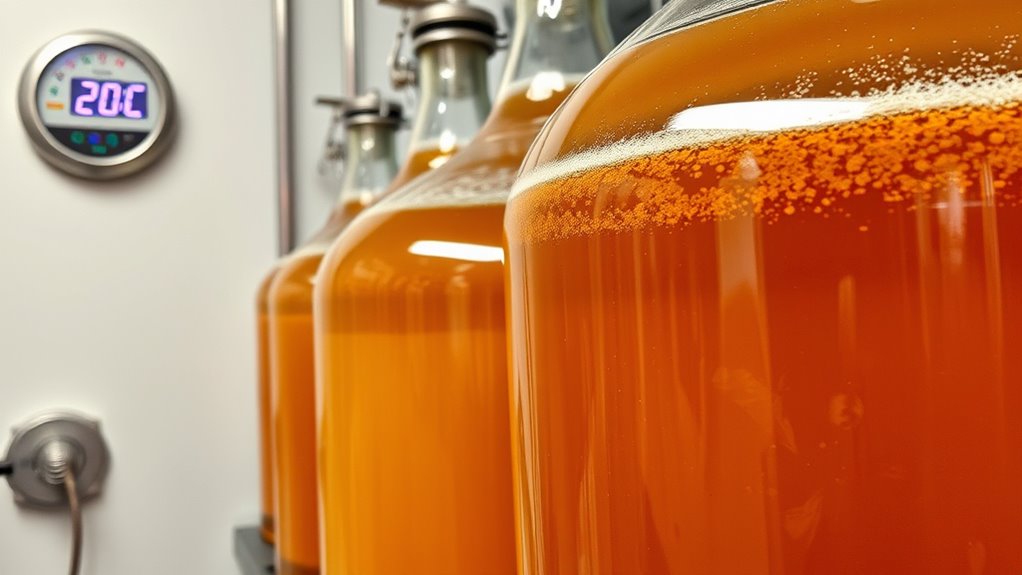
Fermentation techniques and temperature control play an essential role in the development of flavors in your ale. To achieve ideal results, consider these guidelines:
Fermentation techniques and temperature control are crucial for enhancing the flavor profile of your ale.
- Maintain fermentation temperatures between 60-68 °F (16-20 °C) for fruity esters.
- Choose gentle yeast strains like White Labs WLP515 for a balanced flavor profile.
- Implement a diacetyl rest, raising temperatures to 65-70 °F (18-21 °C) for 2-4 days.
- Monitor fermentation activity closely during the first 12 hours.
- Allow 1 to 3 weeks for proper attenuation and flavor development.
Effective temperature management is crucial to prevent temperature swings that can lead to inconsistent flavor profiles and fermentation progression.
Achieving Proper Clarity and Carbonation
Achieving proper clarity and carbonation in your ale is essential for presenting a visually appealing and enjoyable beverage.
Start by allowing your Belgian ales to rest after fermentation for about 2-3 days, enabling sediment to settle.
Consider cold crashing before bottling; this promotes additional sedimentation and reduces haze.
For carbonation, aim for 2.3 to 2.7 volumes of CO2, using accurate priming sugar calculations.
A post-fermentation filtration method can eliminate yeast and particulates, enhancing clarity while preserving flavor.
Finally, monitor fermentation temperatures closely to avoid excessive yeast activity that could cloud your finished beer. Proper sanitization of your brewing equipment is also crucial to prevent contamination and ensure the best quality in your final product, as it eliminates microorganisms that can spoil beer flavor.
Helpful Hints:
- Rest your beer post-fermentation.
- Cold crash for clarity.
- Calculate priming sugar accurately.
Understanding Alcohol Content and Its Impact
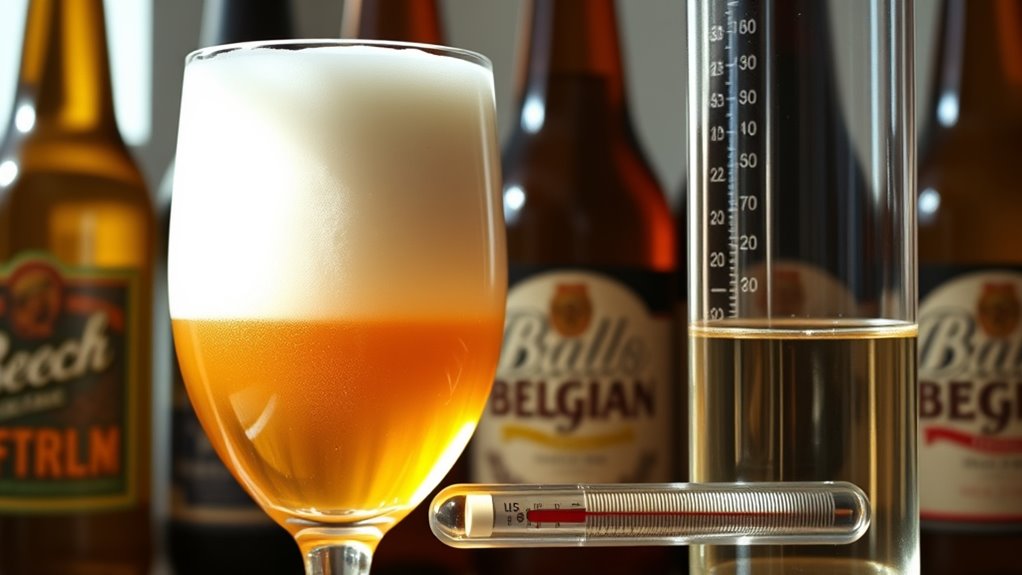
Understanding the alcohol content in Belgian ales is key to both brewing and enjoying these beverages. The typical alcohol content ranges from 5% to 6% ABV, contributing to their drinkability.
Understanding the typical 5% to 6% ABV in Belgian ales enhances both brewing and enjoyment of these flavorful beverages.
Pay attention to the balance between malt sweetness and bitterness, as this can enhance the flavors and aromas.
- Rich malt-forward characteristics
- Subtle warmth from carbonation
- Complex flavor profiles
- Variations in competition scoring
- Adherence to style guidelines
Higher alcohol content can add depth, but make sure you follow style guidelines. Choosing the right yeast strain can also play a significant role in achieving the desired flavor profile. Aim for balance, as judges often favor well-rounded ales that respect the traditional aspects of Belgian brewing.
Flavor and Aroma Profiles of Belgian Ales
When exploring the flavor and aroma profiles of Belgian ales, you’ll find that these beers are distinguished by their rich malt characteristics, which often include notes of bread, toast, caramel, and honey.
The yeast adds subtle fruitiness, showcasing pome and citrus elements. While the hop presence is restrained, it contributes herbal, floral, and spicy notes, ensuring moderate bitterness.
Typically amber to copper in color, Belgian ales avoid excessive yeast character, resulting in a dry finish and medium body for enhanced drinkability.
The well-carbonated beers also feature a large, white head that enhances both the aesthetic and overall drinking experience.
Common Mistakes to Avoid in Brewing
Brewing Belgian ales can be a rewarding endeavor, but common mistakes can jeopardize your efforts and the quality of your final product.
Avoid these pitfalls:
- Neglecting sanitation, leading to off-flavors.
- Over-pitching yeast, causing low final gravity.
- Skipping fermentation resting time, resulting in diacetyl.
- Ignoring clarity, harming your beer’s presentation.
- Failing to follow competition guidelines, risking disqualification.
- Inadequate sanitization of equipment can introduce wild yeast, compromising your brew’s integrity.
Presentation and Labeling for Competitions
Effective presentation and labeling are essential for making a strong impression at beer competitions. To meet competition guidelines, guarantee your entries clearly display the beer’s name, style, and your name.
Use waterproof labels to avoid smudging, and include a unique ID matching your registration. Don’t forget to add alcohol content and original gravity if required.
Package bottles securely with cushioning materials like bubble wrap to prevent breakage. Also, adhere to rules regarding bottle size and shape, as competition organizers often enforce specific restrictions.
Following these steps will enhance your chances of impressing judges and fellow homebrewers alike.
Helpful Hints:
- Check competition guidelines thoroughly.
- Label all necessary information clearly.
- Use appropriate packaging materials.
Evaluating Your Brew: Tasting and Feedback
Evaluating your brew can be an enlightening experience, as it not only helps you understand your beer’s strengths and weaknesses but also lays the groundwork for future improvements.
Focus on these key criteria:
- Aroma: Notice the scent profile, including malt and hops.
- Flavor: Identify sweetness, bitterness, and balance.
- Overall Impression: Consider the beer’s cohesiveness.
- BJCP Guidelines: Use these for style alignment.
- Peer Reviews: Share samples for diverse feedback.
Engaging with fellow brewers fosters innovation. Additionally, monitoring key metrics such as specific gravity can provide valuable insights into your fermentation process.
Document judges’ comments and scores meticulously after competitions, as this information can reveal patterns and guide your brewing journey.
Resources for Homebrewers and Competitors
When preparing for competitions or honing your craft, it’s essential to utilize various resources available to homebrewers and competitors.
Utilizing diverse resources is crucial for homebrewers aiming to excel in competitions and refine their brewing skills.
You should start by reviewing the BJCP guidelines for Belgian ales, ensuring your beer aligns with style criteria. Use brewing software like BeerSmith for precise recipe formulation and calculations.
Joining local homebrew clubs enhances your competition experience through networking and mentorship. Engage with online communities, such as the American Homebrewers Association, to gain insights and advice.
Finally, study past competition results and judges’ feedback to refine your techniques and understand what BJCP judges seek in a winning brew. Additionally, starting with essential equipment can streamline your brewing process and help you focus on perfecting your recipes.
